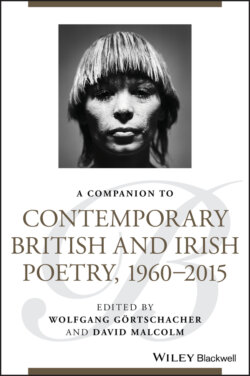Читать книгу A Companion to Contemporary British and Irish Poetry, 1960 - 2015 - Группа авторов - Страница 24
Fleur Adcock, “The Ex‐Queen Among the Astronomers” (1979) (Adcock 1996, 1742–1743)
ОглавлениеThe title of the poem proclaims the opposition that structures it. The poem invents its own myth with figures of male astronomers on one side and the raging, disruptive ex‐queen on the other. The poem's organization of its subject matter expresses this juxtaposition clearly. Stanzas 1–3 present the astronomers—male, using devices to view the universe, diminishing it as they scrutinize it. Stanzas 4 and 5 present the banished ex‐queen, dangerous, constrained by the past, embittered, out for some kind of vengeance. Stanzas 6–8 present her actions as she sexually distracts or intrudes upon the astronomers' sleep and minds.
However, strangely for a poem about disorderly conduct, this text is marked by extreme regularity. Apart from lines 14, 26, and 27, every line has eight syllables. Further, lines with four main stresses predominate, although there are almost as many that are really three‐main‐stress lines, but which—for reasons indicated in the following text—could be read as four‐main‐stress lines. In fact, the poem is not quite as regular in this respect as it might seem at first. Three lines (3, 13, and 25) clearly have five main stresses. Phonology, however, is very consistent: /s/—sometimes modulated to /ʃ/ and /z/—run throughout the whole text. Rhyme is very regular—abca—although one might note that this is not a usual iambic tetrameter rhyme scheme (abab, abcb, or abba might be more readily expected). Rhythmic regularity is very clear in the text too. Almost all lines can be scanned as iambic tetrameters.
However, disorder creeps into the text, as the ex‐queen invades the astronomers' bodies and minds. Enjambment is present throughout—lines 2–3, 3–4, 9–10, 15–16 (perhaps), 21–22, 23–24, 25–26, 26–27, and 29–30 (that is 18 lines out of 32). Further, while it is possible to read almost all lines as iambic tetrameters, to do so frequently requires placing main stresses on unaccented syllables in words (for example, “telescopes”—/x/x—line 7) or function words (for example, “of” in line 4, or “when” in line 8). Such metronomic readings (which the text encourages) are countered by different scansions. For example, one can read line 5—“They calculate, adjust, record”—as x/x/x/x/, but that is a mechanical scansion, and the line should probably be x/xx|x/|x/. The same tension can be observed in many lines. Metronomic order is queried by a more natural placement of stresses. Indeed, there are also several manifestly non‐iambic lines—for example, line 6—“watch transits, measure distances”—which must be scanned //x|/x|/xx. Lines 24, 26, and 27 are similar in this respect.
Thus, a male order is questioned thematically, and an iambic order is challenged in rhythm and meter. However, the orderliness of the poem is assertive, and thematically one must ask what the ex‐queen actually changes with her wild sexual swishing among the astronomers. She is still exiled, they go back to diminishing the stars, and the iambic metronome keeps ticking away.
